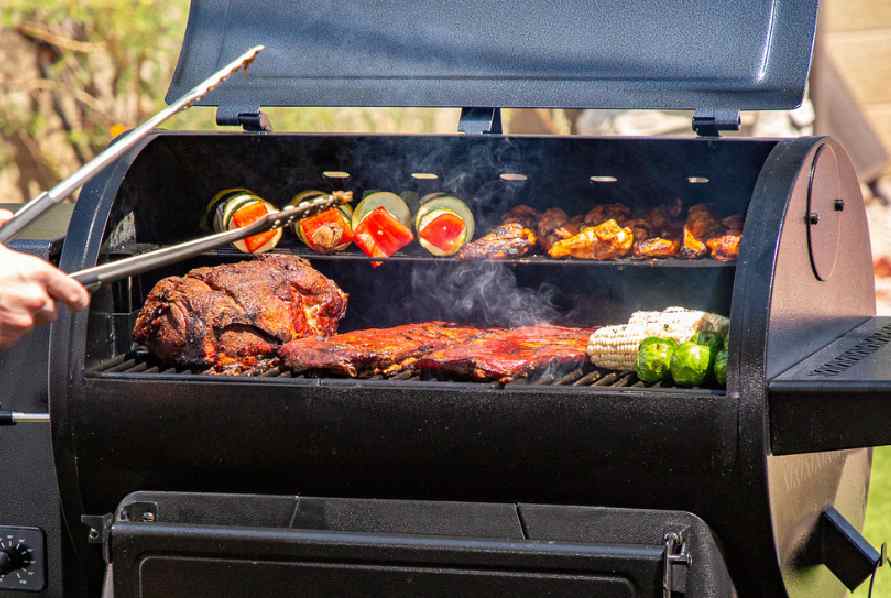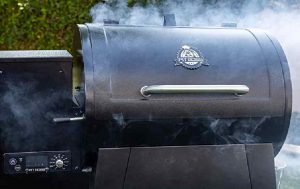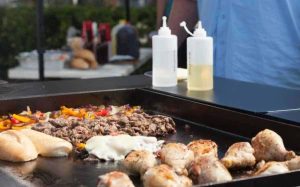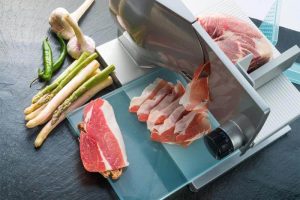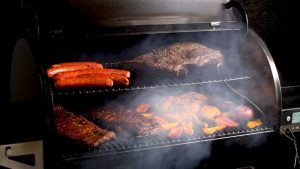Thinking about investing in a pellet grill? Before you make your decision, it’s important to understand the advantages and disadvantages of this unique cooking method.
Dive into the world of pellet grilling and discover if it’s the right choice for you..
- What Exactly Are Pellet Grills And Pellet Smokers? How Do You Operate Them?
- What are The Pros and Cons of Pellet Grills?
- Master the Art of Pellet Grilling: Tips and Tricks for a Flavorful Experience
- Choosing the Perfect Pellet Grill: What to Look For
What exactly are pellet grills and pellet smokers? How do you Operate them?
Have you heard about pellet smokers or pellet grills and wondered what they are and how they differ from other grills?
Worry no more! We’re here to clear up any confusion and help you understand why a pellet smoker might be the perfect addition to your backyard cooking arsenal.
A pellet smoker, also known as a pellet grill, is a versatile outdoor cooking appliance that uses electricity and wood pellets to create heat and smoke for grilling, searing, smoking, roasting, and even baking. It’s like having a grill, smoker, and convection oven all in one!
The process begins by loading wood pellets into the hopper, which then releases them into an auger that moves the pellets to the fire pot.
An ignition rod ignites the pellets, producing heat and smoke. A fan circulates the smoke throughout the cooking space, providing a consistent temperature and smoky flavor.
The temperature is easily controlled with a dial, making it a breeze to use.
While pellet smokers do require an electrical outlet, they’re not considered electric grills since the primary heat source comes from the wood pellets, not electricity.
The electricity is simply used to move the pellets and control the temperature.
The terms “pellet smoker” and “pellet grill” are often used interchangeably, but don’t let that confuse you.
These units are like a combination of a convection oven and a smoker. While they can reach temperatures over 500°F, the heat is ambient, meaning it’s great for even cooking, but not ideal for searing like a traditional grill.
However, they excel at smoking, roasting, and cooking large cuts of meat.
A pellet smoker is an all-in-one solution for outdoor cooking enthusiasts.
Its versatility, ease of use, and ability to deliver delicious, smoky flavors make it a fantastic choice for those who want to explore the world of barbecue and grilling without the need for multiple appliances.
What are The Pros and Cons of Pellet Grills?
Pellet grills are all the rage among BBQ aficionados, and it’s easy to see why. They bring together ease of use, adaptability, and incredible taste.
But, like anything else, they do have their drawbacks that could be a dealbreaker for some folks.
Let’s dive into a well-rounded analysis of pellet grills’ advantages and disadvantages, so you can make a well-informed choice.
Pros of a Pellet Grill:
1. Simple and stress-free:
Pellet grills offer a user-friendly experience, featuring integrated temperature gauges, self-regulating fuel levels, and speedy heat-up times.
This allows you to kick back and enjoy your time, rather than constantly fiddling with the grill.
2. Taste the rainbow:
Pellet grills utilize a variety of flavored wood pellets to impart mouthwatering and fragrant flavors to your food, spanning from sweet to zesty.
Feel free to get creative and blend different pellets together for a one-of-a-kind flavor profile.
3. Clean and precise:
Pellet grills offer a clean cooking experience, with built-in grease and ash collection systems, as well as automatic temperature and fuel adjustments for evenly cooked food.
4. Environmentally friendly:
Pellet grills use renewable resources, produce fewer emissions than charcoal, and are EPA-approved as an eco-friendly grilling option.
5. Temperature control:
Pellet grills are known for maintaining precise temperatures, making it easier to achieve consistent cooking results.
6. Large cooking capacity:
Most pellet grills have a larger cooking area than other types of grills, allowing you to cook more food at once.
7. Versatility:
Pellet grills are capable of grilling, smoking, roasting, and baking, making them a highly versatile outdoor cooking option.
Cons of a Pellet Grill:
1. Lower maximum temperature:
Pellet grills generally have a maximum temperature of 450 degrees Fahrenheit, which can make searing meats or achieving crispy-skinned dishes more challenging.
2. Initial cost:
Pellet grills tend to be more expensive than charcoal or some gas grills, and they require electricity, which can add to your utility bills. Additionally, repairs and accessories can increase the overall cost.
3. Limited portability:
Unlike charcoal grills, pellet grills require an electrical outlet to function and are generally heavier and less portable, making them less suitable for camping or picnics.
4. Electricity dependency:
Pellet grills rely on electricity for operation, which can be a drawback if you don’t have easy access to an outdoor electrical outlet.
5. Wood pellet storage and longevity:
Wood pellets require proper storage to maintain their quality, and they may not last as long as other fuel types.
6. Less smoke production:
Pellet grills produce less smoke than traditional smokers, which may result in a less robust smoky flavor.
7. Weather sensitivity:
Pellet grills can be challenging to use in wet or humid conditions, as moisture can damage both the grill’s electrical components and the wood pellets themselves.
Pellet grills offer a unique outdoor cooking experience, combining convenience, flavor variety, and environmental friendliness.
However, they also come with certain limitations, such as lower maximum temperatures and electricity dependence.
Before purchasing a pellet grill, consider your specific grilling preferences, budget, and outdoor cooking environment to determine if it’s the right choice for you.
Related >> 25 Pellet Grill Tips and Tricks
Master the Art of Pellet Grilling: Tips and Tricks for a Flavorful Experience
If you’ve chosen a pellet grill for your backyard adventures, you’re in for a treat! With the right tips and tricks, you’ll soon be a pellet grilling pro.
1. Choose the Right Wood Pellets:
The secret to a great pellet grilling experience starts with selecting the right wood pellets.
Make sure you use food-grade wood pellets instead of heating pellets, which can be toxic.
Start with the pellets recommended by your grill’s manufacturer to understand what works best with your equipment.
2. Experiment with Flavors:
Don’t be afraid to try different types of wood pellets and cuts of meat. Mix and match wood types and food pairings to find your favorite flavor profiles.
For example, hickory is an excellent choice for pork and chicken but isn’t ideal for seafood. Keep exploring new combinations to make the most of your pellet grill.
Related >> How to Get More Smoke Flavor From Your Pellet Grill (7 Tips)
3. Follow the Manufacturer’s Recommendations:
Always adhere to your grill manufacturer’s guidelines for setup and operation. Ignoring these recommendations could cause irreparable damage to your grill and even pose safety risks.
4. Season Your Pellet Grill:
Take the time to season your pellet grill according to the manufacturer’s instructions. Skipping this step could result in off-tasting meals.
5. Store Pellets Properly:
Wood pellets are sensitive to moisture, so store them in a dry place to keep them fresh and usable.
Use airtight containers and keep them elevated off the ground, regardless of whether they’re stored indoors or outdoors.
If storing outdoors, cover the pellets with a tarp, weigh them down, and ensure the tarp is slanted to prevent water accumulation.
6. Keep the Hopper Clean:
While the hopper can hold pellets for a day or two, it’s not a long-term storage solution. Empty the pellets and store them properly to maintain their quality.
7. Discover Your Grill’s Capabilities:
Get to know your pellet grill and its features, such as cold smoking options on higher-end models. Exploit its versatility to create a wide range of delectable dishes.
Related >> How to Use Wood Pellets in a Charcoal Grill (5 Easy Steps)
Choosing the Perfect Pellet Grill: What to Look For
Selecting the right pellet grill can elevate your outdoor cooking experience to new heights.
To make sure you get the best value and performance, consider these factors when choosing the perfect pellet grill for your needs.
1. Brand Reputation:
Choose a pellet grill from a reputable manufacturer to ensure quality and reliable customer service.
While branded grills may cost more than off-brand options, the investment pays off in the long run through durability and fewer headaches.
2. Size and Capacity:
Consider both the cooking grate capacity and the hopper size to find a grill that matches your needs.
If you plan to cook for large groups or take your grill on camping trips, consider a more portable option with enough cooking space.
3. Budget and Features:
Before shopping, determine your budget and make a list of must-have features versus desirable extras.
This will help you find the best pellet grill within your budget that still meets your needs.
Remember, it’s wise to invest in the highest quality grill you can afford for a better grilling experience.
4. Wood Pellet Compatibility:
Some pellet grills only work with specific brands of wood pellets, which can limit your options or increase costs.
Check the grill’s pellet requirements to ensure compatibility with your preferred pellet brand.
5. Company and Warranty:
Research the grill manufacturer’s warranty to ensure adequate coverage for repairs or replacements. A good company will produce longer-lasting grills and stand behind its products.
6. Temperature Control:
Investigate the grill’s temperature control capabilities, as some models maintain more consistent temperatures than others, especially in varying weather conditions.
7. Hopper and Cooking Space:
Opt for a grill with a sufficient hopper size to prevent frequent reloading during long cooking sessions. Additionally, ensure the cooking space is adequate for your needs.
8. Temperature Range:
Check the grill’s temperature range, as different models have varying high and low operating temperatures. Make sure the grill can reach the temperatures you need for your favorite recipes.
9. Construction and Materials:
Pay attention to the grill’s construction, including the quality of its paint and materials. Stainless steel is a top choice for durability and resistance to rust.
Also, inquire about the firepot’s material, as it’s the most frequently replaced part on pellet grills.
10. Know the Difference Between Cheap and Affordable:
While pellet grills can be expensive, don’t confuse cheap models with affordable ones. Cheaper grills may require more frequent replacements, offsetting the cost of a higher-quality grill.
Related >> How to Use a Pellet Grill (9 Easy Steps)
Final Thoughts
Having weighed the pros and cons of pellet grills, you can now determine if they’re the right fit for your outdoor culinary adventures.
Consider the unique benefits and potential limitations to make a well-informed decision that suits your specific needs.
>> Visit our extensive BBQ guides page for more articles that are similar to this one.
Greetings! I’m Chad, a 43-year-old barbecue aficionado hailing from the beautiful state of Texas. I’m thrilled to invite you on a culinary journey as we explore the art of grilling and smoking together. Through this blog, I aim to ignite your passion for barbecue by offering:
Scrumptious, time-honored BBQ recipes passed down through generations, guaranteed to tantalize your taste buds.
Expert guidance on mastering the grill, smoker, and diverse cooking techniques to elevate your barbecue game.
Recommendations on choosing the perfect tools and equipment tailored to your grilling requirements.
An inside look at the latest trends, innovations, and advancements in the ever-evolving world of barbecue.

